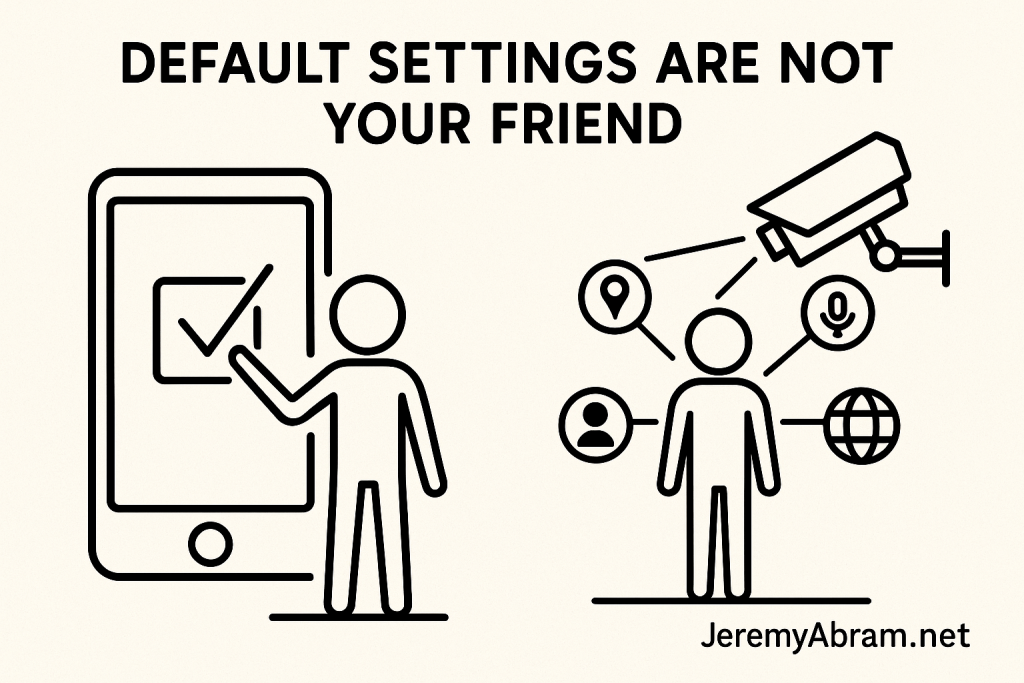
How default options quietly onboard you into data-hungry ecosystems
When you unbox a new phone, install a smart TV, fire up a new app, or connect a wearable, you’re stepping into a design battlefield you rarely see. The screen prompts look helpful. The language feels friendly. The process seems simple.
But simplicity, in the world of modern tech, is seldom neutral.
Default settings are not conveniences — they are quiet onboarding mechanisms into data ecosystems designed to collect, analyze, and monetize your behavior. Behind each toggle and checkbox you didn’t change lies a choice you didn’t really make.
Because in the digital world, inaction is consent — and default settings are designed to ensure that consent never needs to be explicitly asked for.
The Psychology of Defaults
Every interface has a hidden agenda: make the manufacturer’s desired outcome the easiest one to choose.
Tech companies employ cognitive science to shape your decisions:
| Strategy | Effect |
|---|---|
| Friction bias | Adding steps to opt-out makes you more likely to accept defaults. |
| Social norm cues | Labels like recommended imply safety and common usage. |
| Ambiguity advantage | Vague descriptions hide data practices behind friendly language. |
| Speed pressure | Setup screens trigger impatience — you just want to start using the device. |
This isn’t coincidence. It’s behavioral engineering.
The goal isn’t clarity. It’s compliance.
Factory Settings = Factory Surveillance
Let’s decode what “recommended settings” often mean in practice:
✅ Enabled by Default
- Location tracking
- Microphone and camera access
- Usage analytics
- Voice assistant listening states
- Cloud backup of content
- Cross-app data sharing
- Personalized advertising
- Behavioral tracking for “improving services”
❌ Disabled by Default
- Local-only storage
- Manual permission approval
- Strong privacy modes
- Tracking transparency
- Ad personalization controls
- Encrypted logs
- Notification alerts for device-to-vendor data transfers
If the settings you must activate protect you — and the ones already activated benefit the company — you are not the customer.
You are the product.
Defaults as Silent Contract
Every “Accept & Continue” does more than unlock functionality. It enrolls you in a contract — one most users never read. That contract often includes:
- Permission to profile you
- Consent to cross-platform identifiers
- Agreement to machine-learning data retention
- Allowance for third-party transfers
- Consent to biometric inference
- Authorization to store personal content for AI models
You didn’t negotiate this contract.
You inherited it.
Just by not touching the settings menu.
The Hidden Cost of Convenience
We crave effortless experiences:
- Instant sign-in
- One-tap setup
- Content sync across devices
- “It just works”
But frictionless tech is rarely free. The currency is transparency — traded for convenience.
Convenience removes barriers.
Barriers force thought.
And thought threatens data collection.
The easier the setup, the more expensive it usually is — not in dollars, but in autonomy.
Why Companies Love Defaults
Because defaults drive behavior.
According to academic research in behavioral design:
- 90%+ of users never change pre-installed settings
- Users assume defaults reflect best or safest practice
- Defaults shape habits, not just permissions
Silence is compliance.
Inaction is agreement.
Default is destiny — unless you intervene.
How to Reclaim Control
🔍 Before setup
- Research device data policies
- Search for privacy reviews (not just tech reviews)
- Understand ecosystem tie-ins (Amazon, Google, Apple, Meta, etc.)
⚙️ During setup
- Decline “recommended” options
- Disable automatic cloud syncing
- Turn off usage analytics
- Skip linking accounts if possible
- Opt out of ad personalization
🧭 After setup
- Audit permissions monthly
- Check app-level microphone & camera access
- Disable location except when necessary
- Use privacy-focused DNS & VPN
- Review connected-device logs
🛑 When in doubt
Ask: Does this feature improve my life, or improve their data model?
Your Data Preferences Should Be Active, Not Passive
The modern digital world rewards the vigilant and absorbs the passive. Every device whispers the same offer:
“Trust me. Don’t look too closely. Just keep tapping next.”
Your power lies in refusing to operate on autopilot.
Reclaim your settings.
Rewrite the defaults.
Choose intention over convenience.
Because the moment you stop paying attention, the factory configuration starts paying attention to you.
Leave a Reply